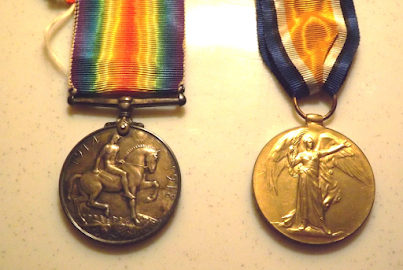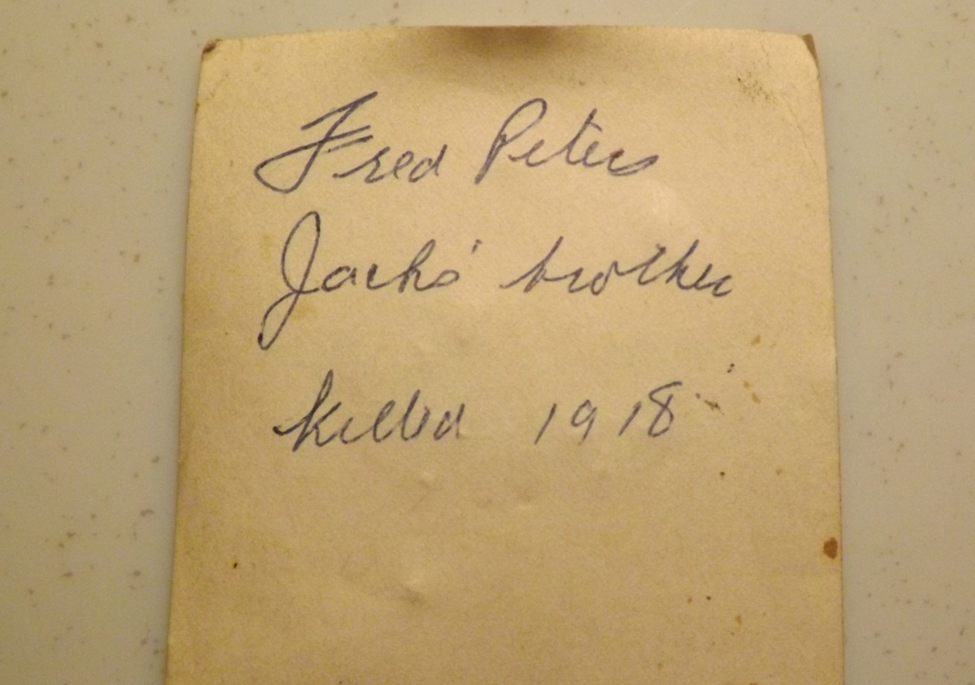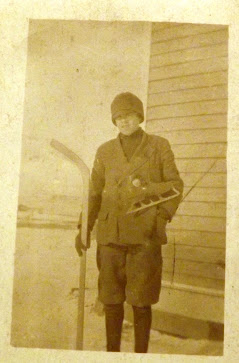A small black case with a crown on it, inside two military medals and a faded picture.
The First World War British War Medal was authorized on 26
July 1919. It was awarded to all ranks of Canadian overseas military forces who
came from Canada between 5 August 1914 and 11 November 1918, or who had served
in a theatre of war. Naval personnel were required to have 28 days of mobilized
service or to have lost their lives before this period of service was complete.
The recipient's name, number and rank are engraved on the rim.
The Victory Medal
was a First World War medal was agreed to by all allies in March
1919. The medal was awarded to all ranks of the fighting forces, to civilians
under contract, and others employed with military hospitals who actually served
on the establishment of a unit in a theatre of war between 05 August 1914 and
11 November 1918. As with the War Medal the recipient's name, number and rank
are engraved on the rim.
The name engraved on the rim of these medals is F G Peters
Boy VR7016, RNCVR
RNCVR stands for Royal Naval Canadian Volunteer Reserve. It
was a naval reserve that was established in Canada in May 1914 and existed
until 1923. During the war, 8,000 officers and ratings joined the RNCVR for
service at home or overseas, including those in the Overseas Division. The
RNCVR crewed 160 vessels, mainly patrol vessels protecting the shores around
Canada and convoy escort duty. The RNCVR rose to prominence during the war,
but, along with the Royal Canadian Navy, was neglected after the war drew to a
close in 1918. Reservists were demobilized, and the organization of the RNCVR
was allowed to lapse due to cuts to the Royal Canadian Navy's budget.
As for “Boy” from its inception in 1910 as the Canadian
Naval Service, until July, 1941, the Royal Canadian Navy (RCN) had a category
of sailor known as “Boy.” They could join as young as age fourteen. This designation was inherited from the
Royal Navy (RN), where it was used as a recruitment device to attract boys,
often from poorer homes or even orphanages, who were too young to meet the
normal entry age of eighteen.
During the hostilities of 1914-1918 the Navy was fighting a
submarine war off its coasts and desperately needed Boys in the Seaman branch –
“Men of Good Character and Physique” – who were sixteen years of age or older.
Any boy approaching the RCN to enlist as a Boy was given only one option, the
Royal Naval Canadian Volunteer Reserve. Many would serve in Canada in whalers,
anti-minesweeping and anti-submarine trawlers and a host of other patrol
vessels.
At home, four Boys were lost out of a crew of thirty-eight
when, in October, 1918, HMCS GALIANO, a patrol vessel, disappeared during a
severe storm in Queen Charlotte Sound.
The service number on the medal leads to the only records
available;
Frederick George Peters Boy Seaman, VR7016, RNCVR Died: 30 Oct 1918 at sea | ||
|
“PETERS, Frederick George, Boy Seaman, VR7016,
RNCVR, MPK - 30 Oct 1918, HMCS GALIANO - Son of C. W. Peters, of
239, 18th Avenue West, East Calgary, AB.”
HMCS GALIANO was the only Canadian naval vessel lost in the
First World War. She foundered on October 30, just weeks before the Armistice
was declared on November 11, 1918.
HMCS GALIANO had
been sent with supplies to the light house at Triangle Island off Cape Scott at
the northwestern tip of Vancouver Island. Her sister ship MALASPINA had been
tasked to re-supply West Coast lighthouses and wireless stations, in particular
the one on Triangle Island that was running perilously short of fuel. Before
MALASPINA could sail, however, she crushed her bow on the jetty, creating the
need for GALIANO to take on the stores and sail in her stead.
GALIANO arrived in
a timely fashion at Triangle Island and thus accomplished her first task
despite a green crew whose numbers had been reduced by the 1918 flu pandemic and
a troublesome boiler. At 5 PM on October 29th, she set sail, bound for stations
in the Queen Charlottes.
When she made her
only distress call at 3 am the next morning, she was estimated to be within
visual range of the light at Cape St. James 95 miles from Triangle Island.
“HOLDS FULL OF WATER – SEND HELP”
The message was
sent by GALIANO’s wireless operator Michael Neary, and received by his brother
W.C. Neary, one of the operators on Triangle Island. She was never heard from
again and went down with the loss of all hands.
There is no picture
of Fred Peters attached to his records. We don’t know his date of birth or age,
there is no mention of Mother or siblings, we know from inscription on the back
of the picture found in the small black case that he must have had a brother.
There must have been a family to receive the medals from a grateful nation,
medals to passed down through the generations until they lost all meaning and
were sold for scrap.
But Fred Peters is more than just a name on the Galiano memorial in Ross Bay Cemetery, more than a line in the book of remembrance in the Peace Tower in Ottawa. He was a young man, a son, a brother and one of those few who stood with the long line of those who really did “stand on guard for thee”.
LEST WE FORGET
The medals of Frederick
George Peters will be donated to the Naden Naval Museum in Esquimalt.



